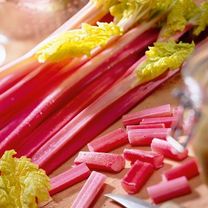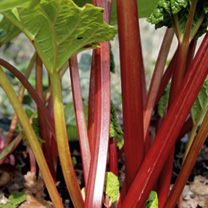Last Updated on March 20, 2023 by the Dobies Horticultural Team
Rhubarb is almost indestructible and once established will become your most reliable cropping spring vegetable. Because it so often eaten as a pud we tend to think of rhubarb as a fruit. Perhaps its dual role earns it the right of being a vegetable, that is also an honorary fruit.
Varieties
Visit our rhubarb category for our complete range of varieties, but just to give you a heads-up:
Victoria – easy to grow with greenish/pinkest stems
Timperly Early – a very early variety, perfect for forcing
Polish Raspberry – another early variety and possibly the best tasting one that our team have ever trialled.
How to Grow
Rhubarb is easy to grow and is best planted when dormant, in late autumn or early spring. Choose a sunny spot in heavily manured soil and allow about 90cm between plants.

After Care
Very little is needed. Any flowering stems need to be cut down to ground level, taking care not to damage the crown.
Rhubarb needs to be exposed to cold weather so pull away any remaining leaves in late autumn. Then add a mulch of well-rooted manure or some garden compost but place this around the plant, leaving the crown uncovered. Just beneath the surface a fat bud or two will be ready and waiting for spring.
Forcing
For an incredibly early and incredibly tasty crop cover your rhubarb crown in January with a tall, upturned pot or dustbin. Being kept in the dark like this will “force” your rhubarb into growth. After about 6 weeks you will have tall, blanched and sweet rhubarb. Simply delicious.
Harvesting
New crowns are best left unpicked during the first year as this will strengthen the crown Thereafter, your rhubarb will crop from late March to July, depending on the variety. To harvest simply select your stem and then pull and slightly twist to free it from the crown. This is so much better than cutting which leaves an open wound. After July stop harvesting and leave the plants alone to recover, many varieties will be a but stringy by now anyway.
Storing
Rhubarb will keep in the fridge for about a week. You can also chop it and freeze it on a tray. Then pop it into a freezer bag, seal and use when needed.
Eating
The dish most associated with rhubarb is of course crumble. And a very fine partnership it is too. Rhubarb also makes a tasty compote when simmered with honey, vanilla and a splash of water. Enjoy this compote with vanilla ice-cream, rice pudding, trifle or just spooned onto your porridge or muesli in the mornings. But remember, rhubarb is a vegetable so works well with savoury dishes. Especially roast pork and mackerel with the addition of ginger, apple or chilli.

